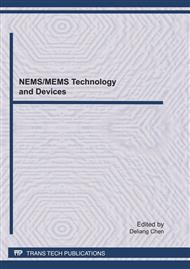p.66
p.70
p.74
p.78
p.82
p.86
p.90
p.94
p.99
Silicon Probes for Cochlear Auditory Nerve Stimulation and Measurement
Abstract:
Cochlear Implant's (CI's) are devices that provides sense of sound to people who are deaf or severely hard of hearing. The important issue with CI's is the electrode design and its placement. The array should be placed close to the modiolar wall of cochlea to stimulate the auditory neurons in accordance with the frequency of the sound and the tonotopic organization of cochlea. It should be flexible for easy surgical insertion and biocompatible enough to withstand the hostile and saline warm environment inside the cochlea. Silicon semiconductor micro-fabrication is an promising technology for advanced CI electrode arrays which will replace the traditional fabrication method. In this paper the design for the silicon electrode array with its consideration is shown. Preliminary simulation results for a stiff probe puncturing the cochlear auditory nerve, which is done to get the stimulation pattern and to realise the mechanical strength of the stiff probe.
Info:
Periodical:
Pages:
82-85
Citation:
Online since:
May 2011
Price:
Сopyright:
© 2011 Trans Tech Publications Ltd. All Rights Reserved
Share:
Citation:


